For years, Thad Matta has taken flak for allegedly not utilizing his bench enough.
I don’t necessarily buy into that argument, at least not as an absolute, because there are so many factors beyond the makeup of the head coach that determine if, or how much, reserves are used over the course of a season.
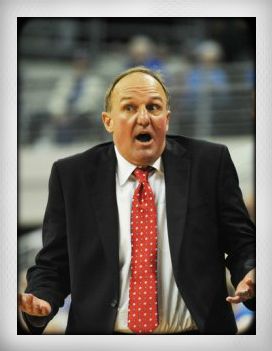 At times, Matta's bench usage has taken some criticism
At times, Matta's bench usage has taken some criticismAs a general premise unrelated to personnel, I’ve always thought the college game is set up perfectly for a coach to heavily, and correctly, lean on his starters.
First of all, at an even remotely legit program, where 100% of games are on television or radio, a team is granted five timeouts not to mention the usual four media timeouts, per half, plus however many of the five timeouts an opponent chooses to take.
Unless it’s a blowout, which would likely mean your starters weren’t logging heavy minutes anyway, that means players would benefit from as many as 18 timeouts in a game that lasts 40 minutes.
Considering the players range in age from roughly 18-22 years old, I think they can stay fresh enough to log 30-35 minutes provided they aren’t in foul trouble, thus potentially sandbagging on defense depending on the game situation.
Other, more specific factors can obviously reshape that ideal. On one hand, relying too heavily on starters can put your team in a bind if a key starter or two fall victim to things like foul trouble or injury, forcing an unprepared player to log crucial minutes. On the other, there are seasons when the roster realizes a major drop off in talent when it starts examining the guys coming off the pine.
Since Matta has absolutely been tagged by many fans and media with the stereotype of a coach who leans too heavily on his starting five, I decided to take a look back and see what the numbers say.
Because we all know the bench is used much more freely during the early season non-conference slate where blowouts are the rule, and I really was more interested in how Thad used his bench during conference games where the competition is fierce, I looked back at the last 3.5 years since that was as far as the team’s site breaks out minutes per game within conference play.
My hope was to get a better feel for exactly how much Thad used his bench over the previous 3.5 seasons while being aware of external factors such as those described above, along with things like the caliber of the starters and to what level the team achieved success.
First up, let's take a look at the makeup of the 2009-10 Buckeyes:
| Player | Games | Tot MPG | Big MPG | Tot PPG | Tot rpg | tot asg |
|---|---|---|---|---|---|---|
| E. Turner | 31 | 35.8 | 35.7 | 20.4 | 9.2 | 5.9 |
| W. buford | 37 | 34.4 | 35.1 | 14.4 | 5.6 | 3.1 |
| J. Diebler | 37 | 37.2 | 38.1 | 13.0 | 2.8 | 1.5 |
| D. Lighty | 37 | 36.3 | 37.1 | 12.6 | 4.5 | 2.9 |
| D. Lauderdale | 36 | 25.1 | 26.6 | 6.5 | 5.2 | 0.3 |
This team was a perfect example of how you can't judge a coach's willingness to use his bench in a vacuum. The 2009-10 Buckeyes had four upper tier players, including a versatile superstar in Evan Turner, while the bench was loaded with nothing but extreme mediocrity. With that roster makeup, Thad rode his horses to a sweep of the B1G regular season and tournament championships and a #2 seed in the Dance.
The B1G tournament was a celebration of Buckeye awesomeness with Turner burying a 37-foot jumper to beat Michigan at the buzzer in the opening round before pouring in 31 points in both the semifinal and championship games. The team did end up underachieving thanks to a 76-73 loss to Tennessee in the Sweet 16, but I would argue the postseason failing had nothing to do with the starters getting too many minutes. Ohio State lost to the Vols because they got crushed on the glass and turned it over three times in the closing minutes. Lighty's minutes limited by foul trouble also didn't help.
Looking at the chart, as you'd expect, Thad leaned heavily on the Big Four with each of them averaging no less than 35 minutes in conference play. Lauderdale got his 25 minutes a night but due to his limitations and occasional foul trouble, Thad often opted to go small.
Overall, the starters played a hefty 80.6% of the total season minutes and they scored 85.6% of the team's total points. Those numbers already tell the tale of the 2009-10 Buckeyes and they'd be even more pronounced if Turner hadn't gone and broken his back dunking on Eastern Michigan, forcing him to miss six games.
Bottom line with this team is that it was a no-brainer for Thad to go all-in with Turner, Buford, Diebler and Lighty. The Buckeyes were in contention for conference championships, played a lot of tight games, and the bench was an absolute dumpster fire.
| player | games | tot mpg | big mpg | tot ppg | tot rpg | tot asg |
|---|---|---|---|---|---|---|
| J. Simmons | 33 | 12.2 | 10.6 | 4.7 | 0.7 | 0.8 |
| P.J. Hill | 27 | 12.2 | 9.6 | 3.2 | 1.2 | 1.2 |
| K. Madsen | 37 | 13.5 | 12.6 | 2.5 | 1.8 | 0.2 |
The disparity in talent between the starters and the bench was incredibly pronounced in 2009-10. I will give some love to Madsen because he was smart, played within himself, gave a legit effort in the paint and would even knock down a feathery baseline jumper every now and again. Still, though Madsen played in all 37 games, he was really just there to spell Lauderdale or to try to keep the Buckeyes physical in the lane when Dallas was in foul trouble.
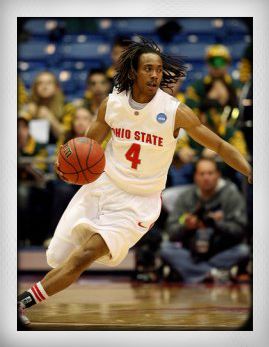 The Predator stated six games with Turner out
The Predator stated six games with Turner outHill built somewhat of a reputation as a pesky defender, though I can't personally say I bought into it. On offense, he did occasionally find success off the drive and dish but his court time was basically either out of necessity when Turner was injured or else mop-up duty.
Simmons was a juco transfer but Thad didn't have the same success going that route as he did with Je'Kel Foster. Simmons played in 33 games and shot 39% from distance on the season but in conference play, he was a liability thanks to 23% shooting overall and 16% from behind the arc. Plus, he was a perimeter player on a team loaded with wings.
Names like Zisis Sarikopoulos and Nikola Kecman also rode the bench, though they can at least claim they were higher in the rotation than the 2nd most famous reserve in OSU history, Mark Titus.
On the year, the bench played just 19.4% of the team's total minutes and scored only 14.4% of the points.
Clearly, Thad was wise to wear out his core four so any talk about not using the bench during this campaign would be foolish.
Let's move on to the 2010-11 Ohio State squad:
| player | games | tot mpg | b1g mpg | tot ppg | tot rpg | tot asg |
|---|---|---|---|---|---|---|
| J. Sullinger | 37 | 31.7 | 33.8 | 17.2 | 10.2 | 1.2 |
| W. Buford | 36 | 32.4 | 33.7 | 14.4 | 3.9 | 2.9 |
| J. Diebler | 37 | 35.7 | 37.7 | 12.6 | 2.6 | 2.4 |
| D. lighty | 37 | 32.1 | 33.8 | 12.1 | 4.0 | 3.3 |
| D. Lauderdale | 37 | 16.1 | 14.3 | 4.2 | 3.2 | 0.2 |
With Buford, Diebler and Lighty back and a game-ready pivot in the form of Sullinger now in the mix, Thad had himself another core four that would dominate the minutes. And this time, though the bench was short, he did have a seasoned veteran in the body of a true freshman to rely on at point guard plus the then-erratic but exciting play of Deshaun Thomas.
The juggernaut started the season ranked #4 and won the first 24 games. The Buckeyes looked like the best team in the country before losing two of the next three with a win over Michigan State sandwiched between road losses to Wisconsin and Purdue. OSU collapsed at Kohl, giving up a 30-8 run after building their own 15-point lead, and the Purdue loss was equally frustrating as Buford racked up two quick fouls and Lighty played drunk. Meanwhile, E'Twaun Moore was scoring 38 for the Boilers.
Of course, the squad bounced back, winning four straight to clinch an outright regular season B1G championship (16-2) before beating Northwestern, Michigan again, and Penn State to win the B1G Tourney.
Despite a 32-2 record and two conference championships, the Buckeyes were screwed by the committee. Ohio State earned the overall #1 seed but their bracket was loaded and in the Regional Semifinals, a talented #4 seed Kentucky squad upset the Buckeyes, 62-60, after Buford's last-second miss from three-point land capped a 2/16 shooting performance.
Even with the B1G trophies and a 34-3 record, the season could still be pointedly, but fairly, summarized as a underachieving disappointment. Still, with the amazing chemistry the team had and how well the core four complemented each other so well, this was a special team.
In total, the starters accounted for 77.9% of the team's points and 73.3% of the total minutes, which represent a 2.7% decrease in points and a 12.3% decrease in minutes compared to the previous season.
| player | games | tot mpg | b1g mpg | tot ppg | tot rpg | tot asg |
|---|---|---|---|---|---|---|
| A. Craft | 37 | 29.6 | 31.3 | 6.9 | 2.9 | 4.8 |
| D. Thomas | 37 | 14.0 | 11.8 | 7.5 | 3.5 | 0.5 |
| J. Sibert | 25 | 8.3 | 4.1 | 2.1 | 1.0 | 0.6 |
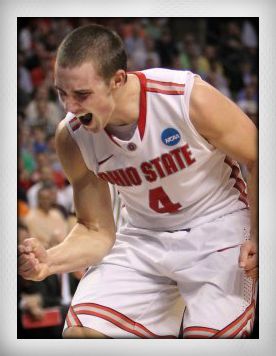 Craft averaged 29.6 min/game off the bench as a frosh
Craft averaged 29.6 min/game off the bench as a froshSince Craft was technically a reserve, he's the most-used bench player in the history of Thad Matta. Even if you consider Craft a starter based on his minutes, this was still one of Matta's better years in both bench development and usage.
In reality, Lauderdale was a reserve and Matta used him wisely, starting him to give the Buckeyes a physical, defensive presence in the lane early on in hopes of keeping Sullinger out of early foul trouble, then working Dallas in to spell Sully ahead of soon-to-come timeouts, affording Jared additional rest.
Deshaun played in every game but still young, his shot selection was at times horrendous and often, his minutes were cut short as Thad yanked him in hopes of teaching a lesson. I think it's fair to say Thad deserves a lot of credit for how he handled Thomas as a freshman based on his growth over the years.
Sibert was basically the victim of having too many studs in front of him and though he played in 25 games, he only averaged 4.1 minutes in 10 B1G games, virtually all of them in garbage time.
Also forced to wait were freshmen Lenzelle Smith Jr. and J.D. Weatherspoon. The pair averaged a combined three minutes while Smith Jr. played in 20 games and 'Spoon just 10. There wasn't much Thad could do with Smith Jr. because wrist surgery the summer before the season limited his development and he was behind names like Buford and Diebler along the wing.
Overall, the bench tallied 22.1% of the team's points and 26.7% of the total minutes. Again, it was a two-man bench but Thad should be credited with using Craft to make the machine go and though the tough love at times with Thomas hurt his minutes, the message eventually sunk in as Thomas is now an elite college player.
Moving on...
| player | games | tot mpg | b1g mpg | tot ppg | tot rpg | tot asg |
|---|---|---|---|---|---|---|
| J. sullinger | 37 | 30.4 | 32.2 | 17.5 | 9.2 | 1.2 |
| d. thomas | 39 | 31.4 | 31.2 | 15.9 | 5.4 | 0.9 |
| w. buford | 39 | 33.8 | 34.2 | 14.5 | 5.0 | 2.7 |
| a. craft | 39 | 32.2 | 31.7 | 8.8 | 3.2 | 4.6 |
| L. Smith jr. | 39 | 25.4 | 25.8 | 6.8 | 4.6 | 2.0 |
As we witnessed over the previous two seasons, Thad again had a core who logged major minutes as the unquestioned top four players, but he also had a young roster filled with guys that were either one-dimensional or just plain raw.
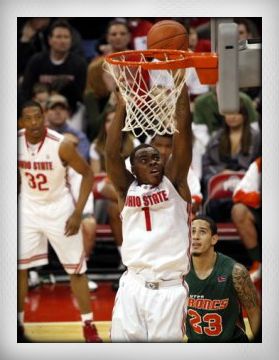 Thomas and Smith Jr. were 1st year starters in 2011-12
Thomas and Smith Jr. were 1st year starters in 2011-12Replacing three starters (Diebler, Lauderdale and Lighty) wasn't as bad as it could've been thanks to Craft's seasoning as a freshman along with an emerging Thomas.
Smith Jr. won the starting gig thanks to a healthy offseason, showing how he could rebound from a guard spot in addition to improving his handles and three-point shot.
The Buckeyes were ranked #3 coming into the year but they were still vulnerable against overly physical or excessively long and athletic opponents. They could be beat on the glass but oftentimes it was a stagnant offense that cost the Buckeyes. One particular stretch in February saw the Buckeyes fall 58-48 at home to Sparty, lose 56-51 in Ann Arbor and 63-60 at home on Senior Day to Wisconsin.
Of course, the Buckeyes bounced back with great vengeance and furious anger, winning nail-biters in Evanston and East Lansing (WB!) to capture another B1G regular season championship before dispatching of Purdue and destroying Michagain in the B1G tourney but then falling to Sparty in the title game.
A #2 seed this time around, the Buckeyes made it all the way to the Final Four. Craft dominated Gonzaga and the Sully/Deshaun combo racked up 35 points, 11 boards and 10 assists to lock up a Sweet Sixteen spot. Sully and Thomas struck again combining for 49 points and 18 boards in a demolition of Cincinnati to secure an Elite Eight bid and the starters accounted for all but eight points in a 77-70 decision over Syracuse, vaulting the Buckeyes to the Final Four. Those eight points were still eight more points than the reserves scored in a combined 29 minutes of action in the loss to Kansas.
Overall, the 31-8 Buckeyes got 83.8% of their points from the starting five while playing 75.8% of the total season minutes. Again, four starters averaged over 30 minutes a night.
| player | games | tot mpg | big mpg | tot ppg | tot rpg | tot asg |
|---|---|---|---|---|---|---|
| e. ravenel | 39 | 10.2 | 8.4 | 3.4 | 2.2 | 0.3 |
| s. thompson | 39 | 10.6 | 12.4 | 2.1 | 1.1 | 0.7 |
| s. scott | 36 | 10.6 | 11.3 | 1.2 | 1.1 | 1.7 |
This crop of reserves was used more than the 2009-10 group (Simmons, Hill, Madsen) but showed a lot more promise. Ravenel was a transfer from BC as Matta looked to shore up depth in the post while Thompson and Scott were still one-dimensional players. Amir Williams was still incredibly raw, though he did show some promise late in the season against legit big men.
Still, the most talked about reserves on this team were Jordan Sibert and J.D. Weatherspoon. It wasn't a mutiny obviously but many fans questioned whether Matta gave either guy enough minutes. They both did actually average more minutes per game over the previous year but neither made headway in the rotation.
Sibert was actually in the regular rotation for much of the non-conference slate but what some fans chose to ignore was that his only strength was his outside shot and the dude was shooting 29% from the floor and 25% from distance. As a result, he only saw mop-up duty in 10 conference games as Thad figured he'd play Scott and Thompson because while they couldn't shoot either, they were much better defenders. Scott was also decent at the drive and dish while Sam could make a highlight reel play and fire up the team every now and then.
Weatherspoon was also capable of a spectacular play but offered little else, certainly not enough to supplant anyone ahead of him in the rotation.
It's fair to wish Matta would've gotten Scott and Thompson more minutes knowing full well they'd be regular rotation guys the following season, but it can't be overlooked that their deficiencies offensively made it difficult for Matta to find them minutes when his starting offense wasn't as good as it had been in the past with Thomas not fully emerging until the back half of the season and Buford's enigmatic play.
In total, the bench scored only 16.2% of the team's points while playing 24.2% of the total season minutes.
Now, with a feel for how the last three years played out, here's how this year's Buckeyes look:
| player | games | tot mpg | big mpg | tot ppg | tot rpg | tot asg |
|---|---|---|---|---|---|---|
| d. thomas | 17 | 33.6 | 37.2 | 20.8 | 6.6 | 1.5 |
| L. smith jr. | 17 | 27.4 | 27.8 | 10.1 | 5.6 | 1.8 |
| a. craft | 17 | 31.8 | 33.4 | 8.7 | 3.2 | 4.7 |
| s. thompson | 17 | 24.0 | 27.2 | 7.0 | 3.5 | 1.1 |
| a. williams | 17 | 15.7 | 16.0 | 4.4 | 4.0 | 0.2 |
Of the last four editions of Buckeye basketball teams, the current crop is the most built for using the bench. But that's a terrible thing because what it's really saying is that there isn't enough separation in overall talent between players 2-8 in regular rotation.
Thomas is doing everything he can to carry the team, pouring in 20.8 points per game even as opposing defenses have virtually no respect for any other offensive threat. He's logging 33.6 minutes a night on the season and 37.2 in league play.
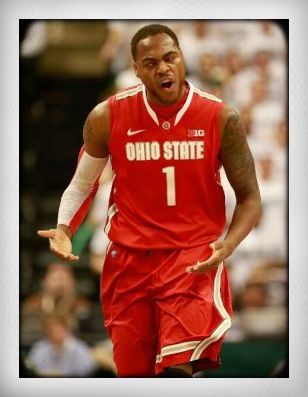 HELP WANTED, YO
HELP WANTED, YOLenzelle Smith Jr. is the 2nd leading scorer but he's shooting worse overall compared to last year (43% TY to 47% LY) and he's reached double figures only once in five B1G games, scoring 17 against a decidedly mediocre Nebraska squad. His sporadic scoring aside, Smith Jr. typically crashes the glass extremely well for a two-guard but he's lucky the only guy on the pine that can shoot is LaQuinton Ross and Ross hasn't shown enough improvement in his all-around game to earn Thad's trust.
Aaron Craft is still doing his thing on defense but he has struggled mightily to step up as an offensive threat. He's playing about the same amount of minutes per game as last year but some would argue he's barely the best point guard on the team as a junior. He's certainly regressed offensively, shooting only 38% this year after hitting 50% of his field goal attempts last season. Even with the hitch in his shooting motion, at this point, it also looks like he's a mental slump at that end of the floor.
Sam is another guy benefitting from Q's erratic play. He's not a bad player. He's a role player on a team that has too many of those. If Thompson was surrounded by a couple more scorers, his game would complement them beautifully. That said, he's basically Ohio State's 4th starter based on overall effectiveness and unlike in past seasons when that player averaged a minimum of 32 minutes, meaning he was still a big-time player, Thompson is averaging only 24 minutes per game.
The 5th starter is the most muddled as both Amir Williams and Evan Ravenel have started games and given Ohio State very little. Williams was handed the starting job six games ago but in five conference games, he's still only averaging 16 minutes, three less than his backup.
Overall, the starters (using Amir's full season stats) are scoring 69.4% of the team's total points while playing 66.3% of the minutes, which represents a huge drop off in both minutes and production compared to the last three seasons. No other starting five in that time period scored less than 78% of the team's total points and played no less than 73% of the total minutes. So, Thad's using his bench, but that's mostly because too many parts are interchangeable. I'm sure he'd rather not have it that way.
| player | games | tot mpg | b1g mpg | tot ppg | tot rpg | tot asg |
|---|---|---|---|---|---|---|
| L. ross | 17 | 16.8 | 11.6 | 8.0 | 3.3 | 0.5 |
| e. ravenel | 17 | 18.8 | 19.4 | 6.1 | 4.5 | 0.4 |
| s. scott | 17 | 21.4 | 22.2 | 5.8 | 2.6 | 4.6 |
We've already touched on most of the guys coming off the bench. Ross is averaging a solid eight points in 17 minutes but he's only getting 11.6 minutes per game thus far in conference play largely because of Matta's level of distrust in his overall game. Ross could most definitely still emerge at some point as a mid-teens per game scorer but not without more minutes. Personally, I think it's time Matta give Ross the same long leash he gives Amir.
Ravenel is actually playing better than Williams. Matta is seemingly just trying to jumpstart Amir by getting him into the flow right from the tip but either way, neither of these guys would've started over Lauderdale.
Scott is the wild card in the equation and would be a starter if he had a yet to be developed outside jump shot. He's at 42% overall (33% 3FG) but is shooting just 22% through five conference games. That said, he has really taken over the duty of creating for others, doing an excellent job of driving and dishing in addition to providing mostly terrific on-ball defense. He's growing but he's still the odd man out when Matta is forced to gamble on Smith and Thompson having respectable shooting nights.
On the season, the bench is scoring 30.6% of the points while playing 33.7% of the total team minutes. Over the last three years, no Buckeye bench had scored more than 22% of the team's points or played more than 26% of the total team minutes.
Therein lies the rub. Oftentimes a team that doesn't go very deep into the rotation means there are 3-4 players that are significantly better players than the rest of roster and when you're talking about 18-22 year-old kids, a strong case can be made that they can handle the extended minutes in today's environment of media timeouts and advanced physical conditioning, training and medicine.
Sometimes, as we've seen at least to this point in Ohio State's season, a deeper bench might mean you've got too many role players and not enough studs.
Again, the Buckeyes are 13-4 so there's plenty going right but they've also lost to four of the five good-to-great teams they've faced, keeping three of them close while getting blown out at Illinois.
With the Buckeyes still searching for a five-man unit that has the potential to consistently click offensively, it will be interesting to see if Thad makes any changes outside the existing patterns.

